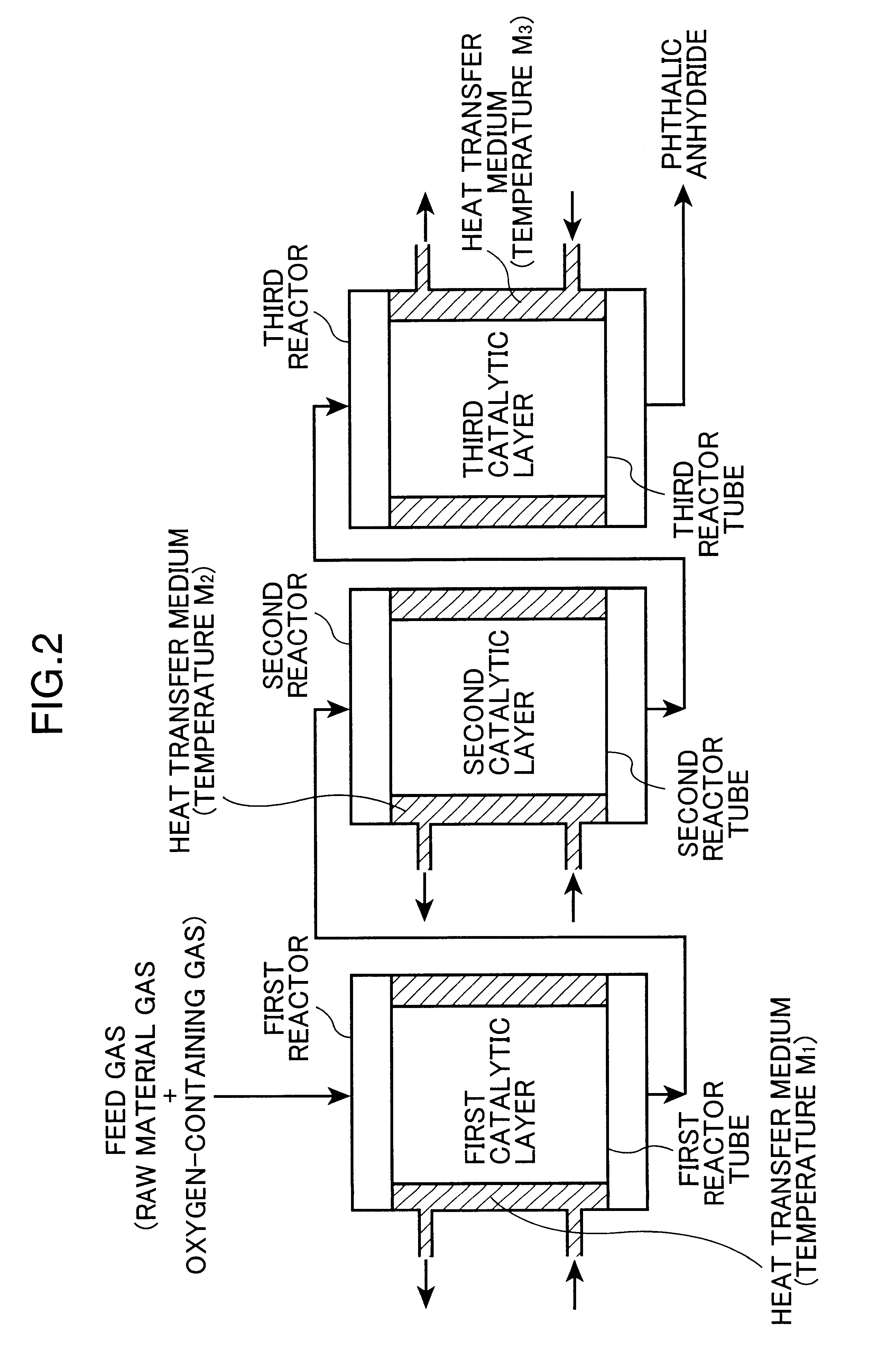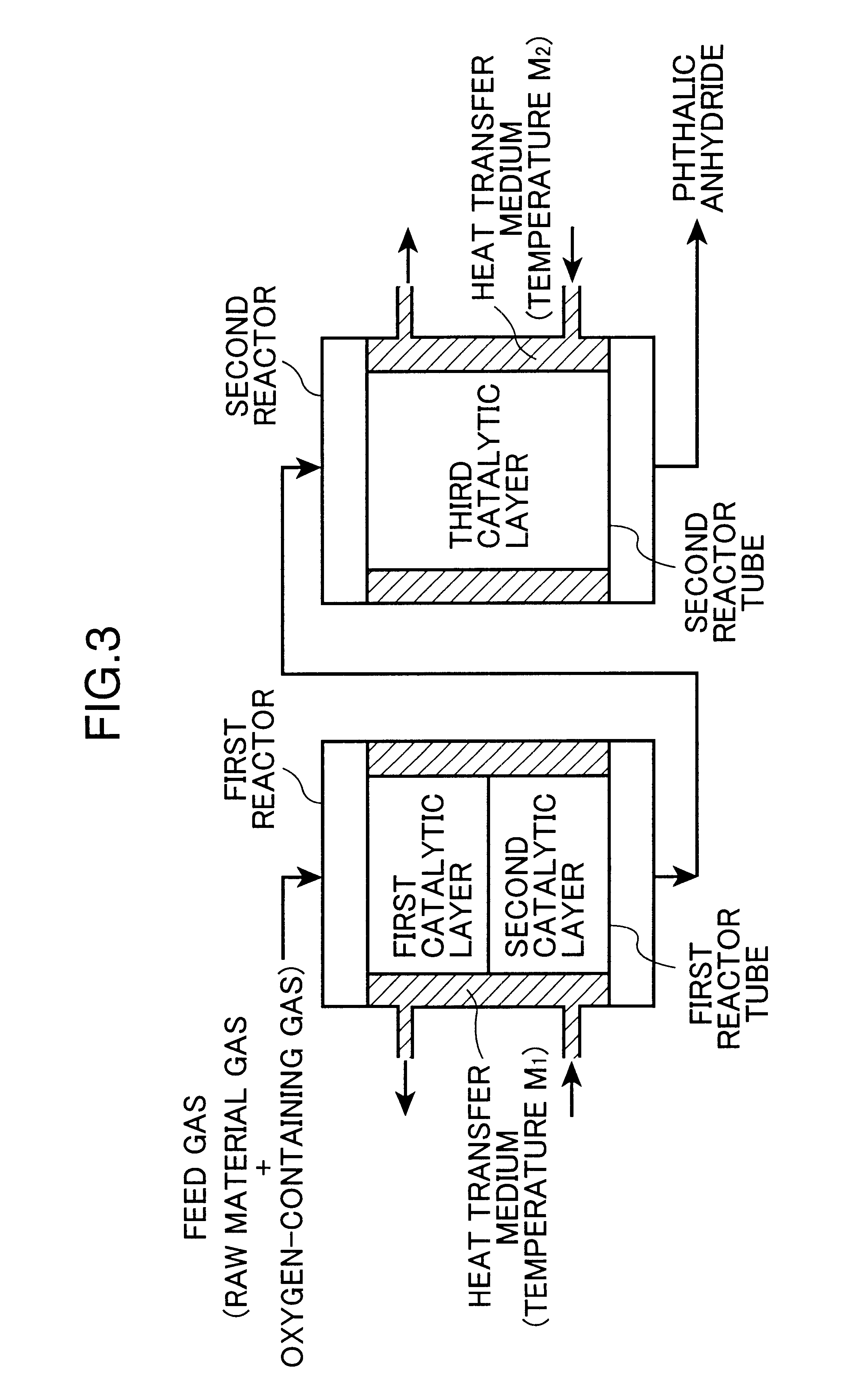Process for producing phthalic anhydride
a technology of phthalic anhydride and process, which is applied in the preparation of carboxylic compounds, organic chemistry, chemistry apparatus and processes, etc., can solve the problems of marked deterioration of catalysts, reducing the yield of phthalic anhydride, and affecting the performance of such catalysts
- Summary
- Abstract
- Description
- Claims
- Application Information
AI Technical Summary
Problems solved by technology
Method used
Image
Examples
production example 1
Into an iron tubular reactor 25 mm in internal diameter and 3.5 m in length, Catalyst C as a third catalyst was packed to a height of 0.9 m to form the third catalytic layer, and onto this layer Catalyst B as a second catalyst was packed to a height of 0.9 m to form the second catalytic layer, and Catalyst A as a first catalyst was then packed thereonto to a height of 0.9 m to form the first catalytic layer.
The above-prepared tubular reactor was dipped into a molten salt bath at 350.degree. C., and a mixed gas containing ortho-xylene and air in a ratio of 100 g / Nm.sup.3 (100 gram of ortho-xylene relative to 1 m.sup.3 of air at standard temperature and pressure) was fed into the dipped tubular reactor at a rate of 4.0 Nm.sup.3 / hr (space velocity at standard temperature and pressure: 3000 Hr.sup.-1).
The yield of phthalic anhydride and the amount of phthalide, an intermediate by-product, were determined respectively at an initial stage of the reaction and 3 months after starting the r...
production examples 2 to 4
Phthalic anhydride was produced in the same manner as in Production Example 1, except that the first, second, and third catalysts were changed to those indicated in Tables 3 and 4, and that the temperatures (M) of the molten salt baths were changed to those indicated in Tables 3 and 4. The conversion rates of the first and second catalytic layers, and the hot spot temperatures of the first, second, and third catalytic layers were measured respectively at an initial stage of the reaction and 3 months after starting the reaction, according to the measuring methods in continuous catalytic layer type system. In addition, the yield of phthalic anhydride and the amount of phthalide were determined. The results are shown in Table 3 (at an initial stage of the reaction) and Table 4 (3 months later).
production example 5
Each individual catalytic layer was formed from a mixture of Catalyst J and a spherical SiC self-sintered carrier having a diameter of 6mm, an apparent porosity of 35% and a purity of 98.5%. The contents of Catalyst J in the mixtures were set to 35% by weight, 60% by weight, and 100% by weight respectively for the first, second, and third catalytic layers.
Respectively at an initial stage of the reaction and 3 months after starting the reaction, the conversion rates of the first and second catalytic layers, and the hot spot temperatures of the first, second, and third catalytic layers were measured, according to the measuring methods in continuous catalytic layer type system. In addition, the yield of phthalic anhydride and the amount of phthalide were determined. The results are shown in Table 3 (at an initial stage of the reaction) and Table 4 (3 months later).
PUM
| Property | Measurement | Unit |
|---|---|---|
| specific surface area | aaaaa | aaaaa |
| porosity | aaaaa | aaaaa |
| porosity | aaaaa | aaaaa |
Abstract
Description
Claims
Application Information
 Login to View More
Login to View More - R&D
- Intellectual Property
- Life Sciences
- Materials
- Tech Scout
- Unparalleled Data Quality
- Higher Quality Content
- 60% Fewer Hallucinations
Browse by: Latest US Patents, China's latest patents, Technical Efficacy Thesaurus, Application Domain, Technology Topic, Popular Technical Reports.
© 2025 PatSnap. All rights reserved.Legal|Privacy policy|Modern Slavery Act Transparency Statement|Sitemap|About US| Contact US: help@patsnap.com



